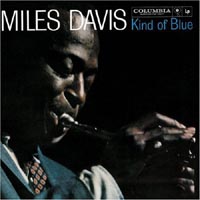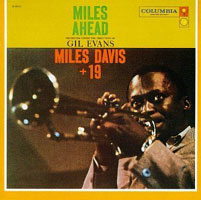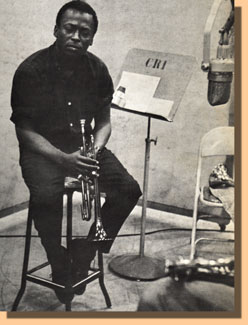

|
Soundclip:
|
| See Steve's Hand-Written Solo
Transcription |
|
Miles Davis' solo on: "So What"(Miles Davis) There are those who would tell you, and argue with you, in a most forceful manner that, Miles Davis' recording, "KIND OF BLUE"(Columbia), is the greatest Jazz record ever made! Recorded on March 2nd, 1959, and with a line-up that included: John Coltrane: tenor sax; "Cannonball" Adderley: alto sax; Bill Evans: piano; Paul Chambers: acoustic bass; and, Jimmy Cobb: drums, it is hard to make an argument against that way of thinking. For some purists, it can seem like all Jazz stopped after this recording. And sometimes, when one is listening to what remains of "Jazz radio" here in the U.S., one gets the painful feeling that this is all too true. Sometimes the feeling is that to most of the music directors it is as if "the music stopped" after 1959. It can be a most sad state of affairs.  Recently, on one lost evening, while 'flipping' the channels on cable TV, I happened to hit upon the "Jazz Channel" offered by Music Choice® and I came upon Miles' solo over his own tune, "So What." Of course, I have heard this tune, this solo countless times, for pleasure, and for study. But, in this moment, I was struck, yet again, by its utter simplicity and its haunting and timeless beauty. A work of art, art in its most minimalist form. When the solo had ended, I asked myself, "Geez, I wonder how many choruses that was?" And so, I went into my music room, located my CD version of the recording and listened to the solo again, learning that it was but 2 choruses in length. I was amazed at how much depth and beauty resided within that amount of space. Yet, it seemed so free and open-ended. Suddenly, I just decided to sit down and write it out. Once I had completed the task, I was again struck by Miles' usage of space, the simplicity of the phrases, but the great depth of what he played and how he played it.
Recently, on one lost evening, while 'flipping' the channels on cable TV, I happened to hit upon the "Jazz Channel" offered by Music Choice® and I came upon Miles' solo over his own tune, "So What." Of course, I have heard this tune, this solo countless times, for pleasure, and for study. But, in this moment, I was struck, yet again, by its utter simplicity and its haunting and timeless beauty. A work of art, art in its most minimalist form. When the solo had ended, I asked myself, "Geez, I wonder how many choruses that was?" And so, I went into my music room, located my CD version of the recording and listened to the solo again, learning that it was but 2 choruses in length. I was amazed at how much depth and beauty resided within that amount of space. Yet, it seemed so free and open-ended. Suddenly, I just decided to sit down and write it out. Once I had completed the task, I was again struck by Miles' usage of space, the simplicity of the phrases, but the great depth of what he played and how he played it.In the Jazz education community, there are also always debates as to just how we can best educate the next generation(s) of players regarding improvisation and to 'speak the language' of Jazz in the best possible way. It has always been my contention that, in taking the first steps, it is of vital importance to give the student a task which is not impossible to accomplish nor is it so difficult to understand the theories behind it. This is why I feel that learning to improvise in simple modal contexts, using smaller challenges enables each player to arrive at a reward much sooner than trying to learn to play over a complex tune from the Bebop era. In my view, doing this can really defeat the desired result, and almost before the quest has begun. "So What" offers a perfectly simple challenge. For one, you are dealing with a classic A-A-B-A, 32-bar song form, with each section being 8 bars in length. To learn and understand form is also a crucial element in the battle. Your [A] sections are all over a simple Dm7 chord over which you should play the D Dorian mode[D, E, F, G, A, B, C]. The [B] section simply goes up a half-step to Ebm7 over which you would play the Eb Dorian mode[Eb, F, Gb, Ab, Bb, C, Db]. The tricky aspect to this, for some players, no matter what the level of experience might be, is that at one point, as the form turns around, you are faced with 48 straight bars of Dm7. It can be easy to lose oneself in that, and then miss the modulation to Ebm7. In other words, you have to be 'in the flow' but always cognizant of just where you are in the form. I think that it is nearly impossible to separate Miles Davis from his tone and style. By 1959, in many ways, it seemed that he had nothing left to prove at this point in his career and so, his playing, his improvising became far less 'notey' and much more minimalist. I remember, growing-up in West Los Angeles, and listening to Jazz on, what used to be, our station there, KBCA. The sound of Miles Davis, especially in the context of his recordings with Gil Evans became the voice of an era. I remember, and vividly so, that the theme song for one of the shows was the Miles/Gil collaboration on Dave Brubeck's "The Duke" which appeared on the recording, "MILES AHEAD"(Columbia).  Nothing ever sounded like that. I'd never heard a 'big band' sound like that. That song, that arrangement, Miles' sound and phrasing just seemed to frame a whole era. To my then uneducated ears, Miles' sound touched upon something deep inside all of us, I always described his sound as that of what any little boy would sound like if he was alone and playing in his room. So, no matter in what context Miles placed himself, nor who the great musicians were that surrounded him in any given moment, he sounded so alone, and yet, right with them all. It was and remains magical. But, beyond the "KIND OF BLUE" recording, Miles Davis went on to set new standards for Jazz with his incredible quintet of the mid-'60s and then, in his way, became the father of the "Jazz-Rock Fusion" movement, which perhaps began when "Miles went electric" on "MILES IN THE SKY." Throughout it all, he was still the great minimalist. Nothing ever sounded like that. I'd never heard a 'big band' sound like that. That song, that arrangement, Miles' sound and phrasing just seemed to frame a whole era. To my then uneducated ears, Miles' sound touched upon something deep inside all of us, I always described his sound as that of what any little boy would sound like if he was alone and playing in his room. So, no matter in what context Miles placed himself, nor who the great musicians were that surrounded him in any given moment, he sounded so alone, and yet, right with them all. It was and remains magical. But, beyond the "KIND OF BLUE" recording, Miles Davis went on to set new standards for Jazz with his incredible quintet of the mid-'60s and then, in his way, became the father of the "Jazz-Rock Fusion" movement, which perhaps began when "Miles went electric" on "MILES IN THE SKY." Throughout it all, he was still the great minimalist.Before I begin the analysis, it is important to note that, as this site is often frequented by guitarists seekign information and knowledge, I have written the transcription in its concert key, but, it is written one octave above where it would sound. In other words, for a guitarist reading along, it would sound perfect with Miles' trumpet. Everyone else has to do some transposing of register. After the melody statement, which features Paul Chambers' acoustic bass, Miles begins his solo by playing a series of short phrases, all of which are centered around D minor pentatonic[D, F, G, A, C]. His phrasing is always relaxed and, at times, played purposefully behind the beat. This is a subtle but most important aspect to command in one's phrasing. When he plays two 8th-notes at the end of any phrase, you will notice that the phrase markings are always 'long'-'short.' This is what signals to everyone the sense of 'swing.' In bars, 5-7 of [A2] of Chorus 1, he vaults up to the beautiful colors tones of the 9th[E] and the 11th[G]. Notice the rests, the spaces he leaves for Bill Evans to fill with his beautiful 4ths oriented open-style voicings. As the first [B] modulation arrives, Miles' lines take on a bit more of a linear feel and drift away from the pentatonic approach. You also hear his usage of the color tone of the major 7th[D-natural] in bar 7, and again, a C# as he transits back to [A3] and D Dorian. Once again, the solo returns to a more pentatonic focus. As Chorus 2 begins, Miles again seems to concentrate on the extensions, the color tones of the 9th[E] and the 11th[G], spreading them out over the 8-bars. At bar 1 of [A2] of this chorus, he plays a beautiful and simple blues-oriented phrase with the inclusion of the 'blue note', Ab. One must never forget that the 'blues' is always an element, an undercurrent, of any Jazz improvisation.  For the remainder of this 8-bar section, he returns to his more pentatonic oriented phrases. In bar 7, as the section concludes, he introduces the degree of the 13th or 6th, by placing some subtle emphasis on B-naturals. Anticipation of the mode to come is also an important improvising device, and Miles strongly plays a high Ab to signal the arrival of the modulation and the Ebm7 chord. As it was in the prior [B] section, his playing becomes a bit more linear again. As he emerges from the section, he anticipates the arrival of the final [A] section by playing 3-and-4-and in D Dorian. Again, he uses scale tones to rise towards a high 'G'(the 11th) which falls down to an E-natural. He concludes the solo with a line in bar 6 which rises to another E-natural and falls to chord tones of 'C' and 'A' before coming to rest on one final 'D' which is the root, of course. As John Coltrane begins his solo, his first three notes are D-F-G rising to an A-natural. Again, it begins as a very pentatonic approach. For the remainder of this 8-bar section, he returns to his more pentatonic oriented phrases. In bar 7, as the section concludes, he introduces the degree of the 13th or 6th, by placing some subtle emphasis on B-naturals. Anticipation of the mode to come is also an important improvising device, and Miles strongly plays a high Ab to signal the arrival of the modulation and the Ebm7 chord. As it was in the prior [B] section, his playing becomes a bit more linear again. As he emerges from the section, he anticipates the arrival of the final [A] section by playing 3-and-4-and in D Dorian. Again, he uses scale tones to rise towards a high 'G'(the 11th) which falls down to an E-natural. He concludes the solo with a line in bar 6 which rises to another E-natural and falls to chord tones of 'C' and 'A' before coming to rest on one final 'D' which is the root, of course. As John Coltrane begins his solo, his first three notes are D-F-G rising to an A-natural. Again, it begins as a very pentatonic approach.When one is trying to learn to improvise, whether it is to play "Jazz" or to operate within another genre, there always seems to be a rush to be playing as fast as one can, as soon as is possible. This is often favored over learning to capture the 'feeling' of the music, of the particular song, and to, above all, be 'in the flow' of time feel. This is why I believe that if, as in the case of "So What", you can learn these two simple Dorian modes and some very fundamental minor pentatonic ideas, you can, at the very least, be playing notes which always sound good so that you can then concentrate on just feeling as though you are in the flow of the time, the groove, of the music and can make your ideas sit within the music as a whole. The secret is that you don't have to play anything particular fancy or what someone else might judge as being particularly creative, different, or strikingly individualistic. You just have to be musical and learn to attach your own personal feelings to each note you play. When you listen to Miles Davis, you can tell that he has such a feeling for each note, for each phrase. It is more important, in my view, to capture this first, than to be possibly frustrating yourself by attempting to become a Bebop master at the start. This can come at a later stage, and by doing what I am suggesting first, you will be far better prepared for that future stage. As is our custom, we are hoping that everyone will find something to enjoy about this wonderful solo by a musician who looms as a figure far more grand than he probably could have imagined when he first picked-up the trumpet. But don't ever forget, there is so much great, great music in this genre after 1959, after "KIND OF BLUE." Find it, and explore it too!
[Photo of Miles Davis by: Don Hunstein]
|